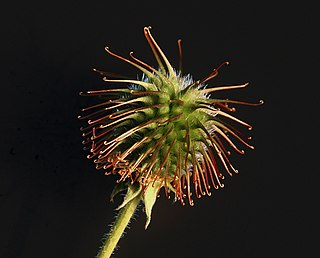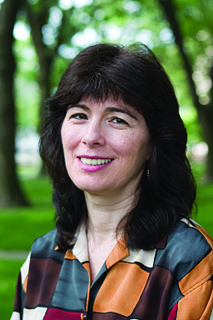
Biomimetics or biomimicry is the emulation of the models, systems, and elements of nature for the purpose of solving complex human problems. The terms "biomimetics" and "biomimicry" are derived from Ancient Greek: βίος (bios), life, and μίμησις (mīmēsis), imitation, from μιμεῖσθαι (mīmeisthai), to imitate, from μῖμος (mimos), actor. A closely related field is bionics.
Bio-inspired computing, short for biologically inspired computing, is a field of study which seeks to solve computer science problems using models of biology. It relates to connectionism, social behavior, and emergence. Within computer science, bio-inspired computing relates to artificial intelligence and machine learning. Bio-inspired computing is a major subset of natural computation.

Bionics or biologically inspired engineering is the application of biological methods and systems found in nature to the study and design of engineering systems and modern technology.

Nanobiotechnology, bionanotechnology, and nanobiology are terms that refer to the intersection of nanotechnology and biology. Given that the subject is one that has only emerged very recently, bionanotechnology and nanobiotechnology serve as blanket terms for various related technologies.

The lotus effect refers to self-cleaning properties that are a result of ultrahydrophobicity as exhibited by the leaves of Nelumbo, the lotus flower. Dirt particles are picked up by water droplets due to the micro- and nanoscopic architecture on the surface, which minimizes the droplet's adhesion to that surface. Ultrahydrophobicity and self-cleaning properties are also found in other plants, such as Tropaeolum (nasturtium), Opuntia, Alchemilla, cane, and also on the wings of certain insects.

Markus J. Buehler is an American materials scientist and engineer at the Massachusetts Institute of Technology (MIT), where he holds the endowed McAfee Professorship of Engineering chair. He is a member of the faculty at MIT's Department of Civil and Environmental Engineering, where he directs the Laboratory for Atomistic and Molecular Mechanics (LAMM), and also a member of MIT's Center for Computational Science and Engineering (CCSE) in the Schwarzman College of Computing. His scholarship spans science to art, and he is also a composer of experimental, classical and electronic music, with an interest in sonification. He has given several highly acclaimed TED talks about his work.
The Max Planck Institute of Colloids and Interfaces is located in Potsdam-Golm Science Park in Golm, Potsdam, Germany. It was founded in 1990 as a successor of the Institute for Physical Chemistry and for Organic Chemistry, both in Berlin-Adlershof, and for Polymer Chemistry in Teltow. In 1999, it transferred to newly constructed extension facilities in Golm. It is one of 80 institutes in the Max Planck Society (Max-Planck-Gesellschaft).
Biomimetic materials are materials developed using inspiration from nature. This may be useful in the design of composite materials. Natural structures have inspired and innovated human creations. Notable examples of these natural structures include: honeycomb structure of the beehive, strength of spider silks, bird flight mechanics, and shark skin water repellency. The etymological roots of the neologism biomimetic derive from Greek, since bios means "life" and mimetikos means "imitative",
Bioinspiration & Biomimetics is a peer-reviewed journal that publishes research involving the study and distillation of principles and functions found in biological systems that have been developed through evolution. It was quarterly during 2006~2014 and became bimonthly in 2015.
The Biomimicry Institute is non-profit organization based in Missoula, Montana, United States. It was founded in 2006 by Bryony Schwan and Janine Benyus; a natural sciences writer, innovation consultant, and author of six books, including Biomimicry: Innovation Inspired by Nature.

The Wyss Institute for Biologically Inspired Engineering is a cross-disciplinary research institute at Harvard University which focuses on developing bioinspired materials and devices for applications in healthcare and sustainability. The Wyss Institute was launched in January 2009 with a $125 million gift to Harvard—at the time, the largest single philanthropic gift in its history—from Hansjörg Wyss. In 2013, Hansjörg Wyss doubled his gift to $250 million and in 2019 he donated a further $131 million.

Bio-inspired robotic locomotion is a fairly new subcategory of bio-inspired design. It is about learning concepts from nature and applying them to the design of real-world engineered systems. More specifically, this field is about making robots that are inspired by biological systems. Biomimicry and bio-inspired design are sometimes confused. Biomimicry is copying from nature while bio-inspired design is learning from nature and making a mechanism that is simpler and more effective than the system observed in nature. Biomimicry has led to the development of a different branch of robotics called soft robotics. The biological systems have been optimized for specific tasks according to their habitat. However, they are multifunctional and are not designed for only one specific functionality. Bio-inspired robotics is about studying biological systems, and look for the mechanisms that may solve a problem in the engineering field. The designer should then try to simplify and enhance that mechanism for the specific task of interest. Bio-inspired roboticists are usually interested in biosensors, bioactuators, or biomaterials. Most of the robots have some type of locomotion system. Thus, in this article different modes of animal locomotion and few examples of the corresponding bio-inspired robots are introduced.

The tubercle effect is a phenomenon where tubercles or large 'bumps' on the leading edge of an airfoil can improve its aerodynamics. The effect, while already discovered, was analyzed extensively by Frank E. Fish et al in the early 2000 onwards. The tubercle effect works by channeling flow over the airfoil into more narrow streams, creating higher velocities. Another side effect of these channels is the reduction of flow moving over the wingtip and resulting in less parasitic drag due to wingtip vortices. Using computational modeling, it was determined that the presence of tubercles produces a delay in the angle of attack until stall, thereby increasing maximum lift and decreasing drag. Fish first discovered this effect when looking at the fins of humpback whales. These whales are the only known organisms to take advantage of the tubercle effect. It is believed that this effect allows them to be much more manoeuvrable in the water, allowing for easier capture of prey. The tubercles on their fins allow them to do aquatic maneuvers to catch their prey.
Biomimetic architecture is a branch of the new science of biomimicry defined and popularized by Janine Benyus in her 1997 book. Biomimicry refers to innovations inspired by nature as one which studies nature and then imitates or takes inspiration from its designs and processes to solve human problems. The book suggests looking at nature as a Model, Measure, and Mentor", suggesting that the main aim of biomimicry is sustainability.

Joanna Aizenberg is a professor of chemistry and chemical biology at Harvard University. She is the Amy Smith Berylson Professor of Materials Science at Harvard's School of Engineering and Applied Sciences, the co-director of the Kavli Institute for Bionano Science and Technology and a core faculty member of the Wyss Institute for Biologically Inspired Engineering. She is a prominent figure in the field of biologically inspired materials science, having authored 90 publications and holding 25 patents.
The Salvinia effect describes the permanent stabilization of an air layer upon a hierarchically structured surface submerged in water. Based on biological models, biomimetic Salvinia-surfaces are used as drag reducing coatings (up to 30% reduction were previously measured on the first prototypes. When applied to a ship hull, the coating would allow the boat to float on an air-layer; reducing energy consumption and emissions. Such surfaces require an extremely water repellent super-hydrophobic surface and an elastic hairy structure in the millimeter range to entrap air while submerged. The Salvinia effect was discovered by the biologist and botanist Wilhelm Barthlott and his colleagues and has been investigated on several plants and animals since 2002. Publications and patents were published between 2006 and 2016. The best biological models are the floating ferns with highly sophisticated hierarchically structured hairy surfaces, and the back swimmers with a complex double structure of hairs and microvilli. Three of the ten known Salvinia species show a paradoxical chemical heterogeneity: hydrophilic hair tips, in addition to the super-hydrophobic plant surface, further stabilizing the air layer.
Self-cleaning surfaces are a class of materials with the inherent ability to remove any debris or bacteria from their surfaces in a variety of ways. The self-cleaning functionality of these surfaces are commonly inspired by natural phenomena observed in lotus leaves, gecko feet, and water striders to name a few. The majority of self-cleaning surfaces can be placed into three categories: 1) superhydrophobic, 2) superhydrophilic, and 3) photocatalytic.
Bio-inspired photonics or bio-inspired optical materials is a subcategory of bioinspiration. It includes artificial materials with optical properties springing inspiration from living organisms. This differs from biophotonics which is the field of study on the development and application of optical techniques to observe biological systems. In living organisms, colours can originate from pigments and/or unique structural characteristics.
This glossary of nanotechnology is a list of definitions of terms and concepts relevant to nanotechnology, its sub-disciplines, and related fields.

A microswimmer is a microscopic object with the ability to move in a fluid environment. Natural microswimmers are found everywhere in the natural world as biological microorganisms, such as bacteria, archaea, protists, sperm and microanimals.











